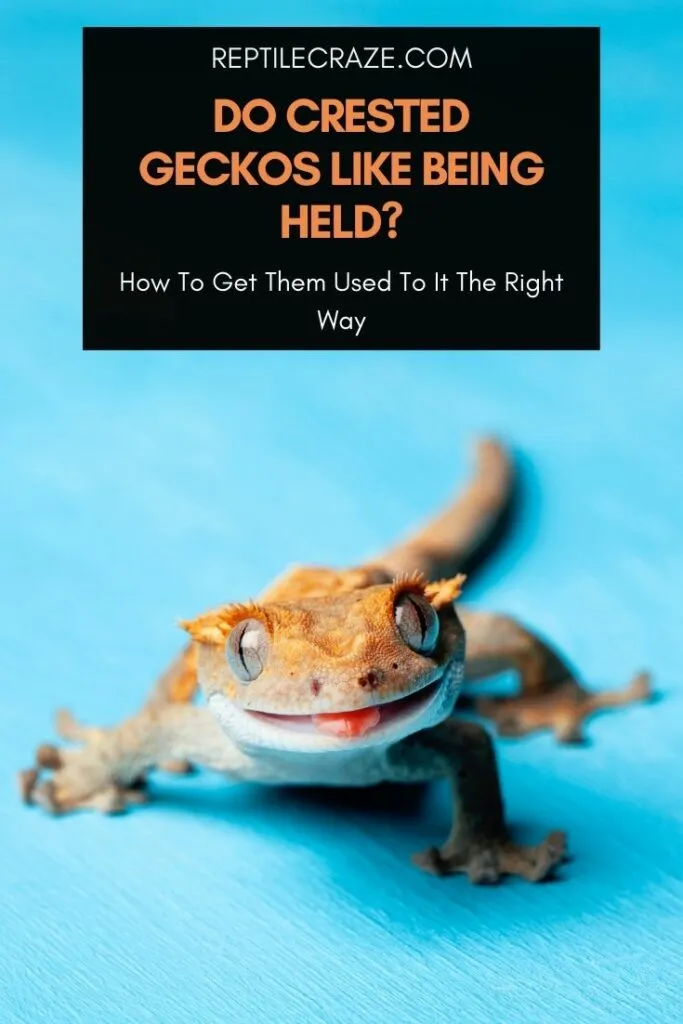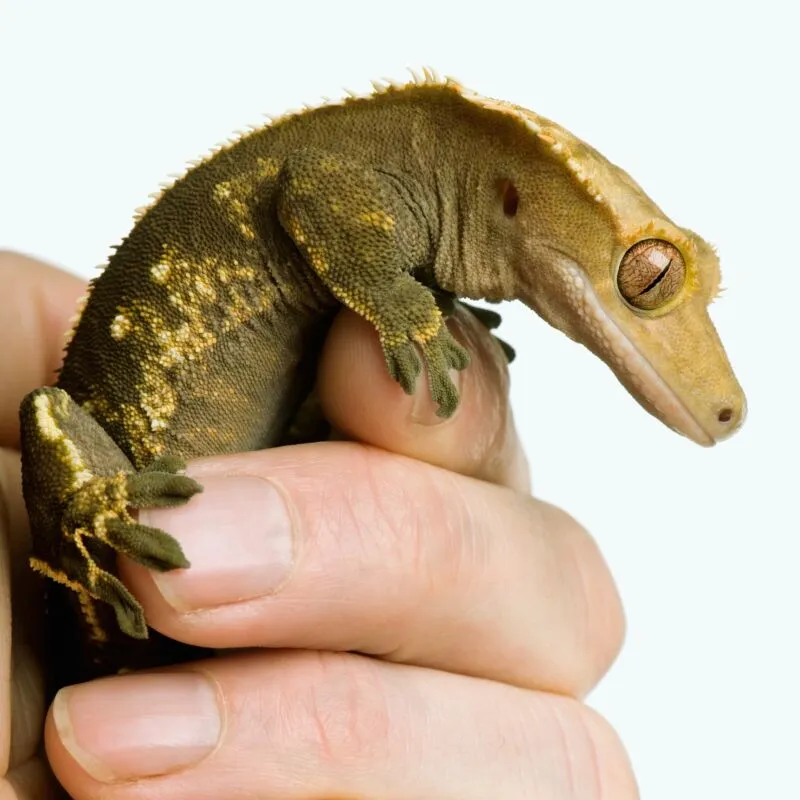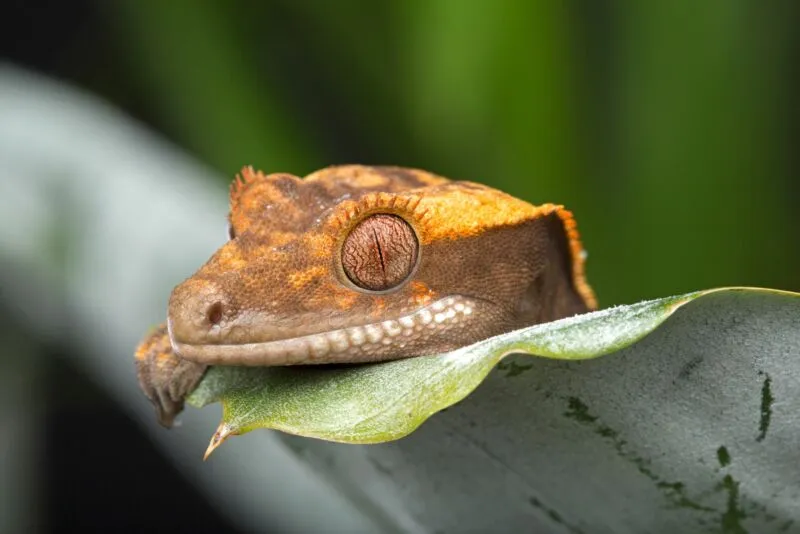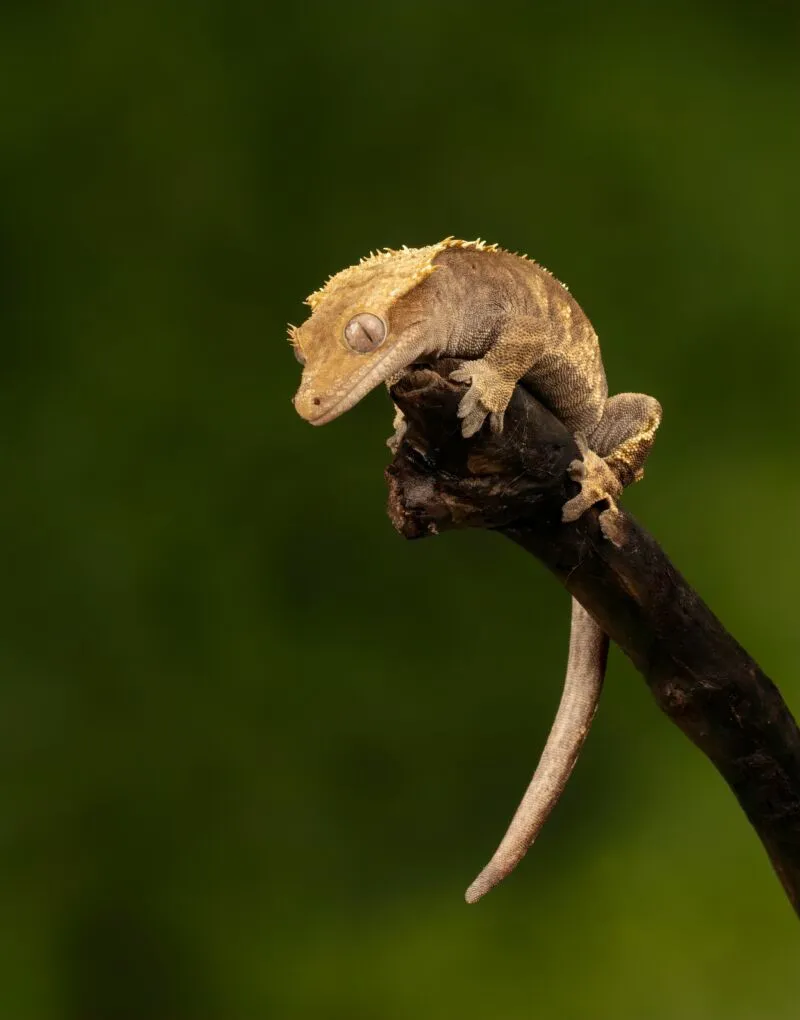
Crested Geckos are some of the cutest pet lizards and you can’t help but want to hold them. However, you’ve probably heard a lot of different opinions about whether cresties should or shouldn’t be held and whether or not they like being handled. Here’s what we’ve found.
Like most reptiles, crested geckos don’t really like to be held. However, crested geckos are more docile than many other lizards and, with care and patience, most get used to being held and handled over time. This doesn’t mean that they like being held, it is assumed that they just tolerate it.
When you’re interacting with your crested gecko and holding them, you always need to be aware of their body language and movements. These will give you clues as to whether your crestie is enjoying its interaction with you, or whether you should rather return them to their
In this article, we’ll have a look at what different body language and actions mean when you’re holding your crested gecko as well as how to hold your gecko safely. We’ll end with a discussion on how long you can keep them outside their
Table of Contents
Signs Your Crested Gecko Likes To Be Held
When you’re interacting with your crested gecko, they will show you that they are enjoying their interaction with you through their body language. This may already be evident if they come towards you when you want to pick them up to take them out of the
A crestie walking around on you – for example up your arm to your shoulder – is a good sign, as it means that your crested gecko has learned to trust you. They may also want to stay on your hands for some of their heat, or jump from hand to hand.
Tip: Because crested geckos love jumping so much, always be extra careful that they don’t fall when they’re outside their
tank . Be especially careful of hard floors like wooden or tile floors, as these may cause greater injury to your crestie if they should fall.
Your crested gecko may also show a playful side by jumping away from you, so make sure that they’ll have a soft landing spot.
This can include a bed, cushions, etc. A healthy crestie is an active crestie, so be prepared for any shenanigans that might come your way!

Remember that crested geckos aren’t like dogs or cats and can’t be cuddled or petted in the same way. They also don’t show affection in the same way that those pets do.
Handling your crestie and keeping an eye on their body language is a good way to keep an eye on their health. But you should also know when enough is enough.
Let’s look at what your crested gecko will do when they don’t want to be held.
Signs Your Crested Gecko Does Not Want To Be Held
The first thing you’ll most likely notice when you want to hold your crested gecko and they don’t want to be held, is that your crestie runs or jumps away from you before you’ve even picked them up.
They may also try to bite you as a way of defense in the hopes that it will cause you to leave them alone.
Don’t worry though – just in case you don’t get the message and take your hand away – cresties don’t give serious bites, unlike some of the other pet reptiles.
Because crested geckos are so docile, biting is an extremely clear sign that they’re unhappy.
Your crestie may also start moving their tail in an ‘s’. This also conveys some serious agitation and they may even feel threatened.
It’s therefore imperative that you put your crestie down as they’re likely to drop their tail if the warning isn’t heeded.
What Happens If You Keep Handling Your Crested Gecko When They Don’t Want To Be Held?
If you keep handling your crestie even when their body language shows you that they don’t want to be picked up or held, they can:
- become aggressive and bite you
- can jump away from you, potentially hurting themselves
- become stressed enough to drop their tail
What To Do If Your Crested Gecko’s Tail Drops Off
Don’t worry, you don’t need to do much when the tail drops off except remove your crestie from the extremely stressful situation that made them drop their tail in the first place.
Then, keep an eye on your crestie to ensure that the healing wound doesn’t become infected.
The bleeding should stop almost immediately and your crested gecko will need a few days to adjust to their new way of balancing, but otherwise the loss of the tail is usually a bigger deal for the owner than the crestie themselves.
You can also, for the first few days after the tail has fallen off, keep your crestie in the “hospital”
If you do see that the wound is infected, you can contact your local vet for an appointment to take care of the infection. Don’t wait to see if the infection will “clear up by itself”, though. The sooner you take care of it, the better for your crestie.
How To Get Your Crested Gecko Used To Being Held And Taken From Their Tank

There are certain steps that you should take to ensure that your crested gecko trusts you and will interact with you before you pick them up, hold them, and take them out of their
This will help to keep your crestie safe as they will be less likely to jump away from you (and maybe fall to the floor) and get injured. They are also less likely to try and bite you if they are used to you and don’t see you as a threat to them.
Step 1 – Get them used to you
First of all, you need to let your crestie get used to you and know that you’re not a threat to their safety. If your crested gecko is brand new to your home, give them time to first get used to its environment and you feeding them before starting to interact with them more.
Even just spending time in the same room as your crestie will help your crested gecko get used to you and your smell.
Step 2 – Only pick them up
Once your crested gecko is used to you, you can start to pick them up (keep reading to find out the best way to pick up your crestie) and interact with them.
At this time, only pick them up and handle them while they’re still inside or partially inside their
Once your crestie is used to being picked up and lifted from the
Step 3 – Remove them from their tank for short lengths of time
Now that your crestie is used to being handled by you, you can remove them from their
Start with only a few minutes at a time and work your way up to 10 minutes, then 15 and then 20 minutes.
You shouldn’t keep your crested gecko outside their
Note! If you see that your crestie is starting to get stressed, return them to their
How To Properly Pick Up And Handle Your Crested Gecko
Picking up your crested gecko properly and handling them softly and safely are some of the first skills that you need to master with your crestie.
In the following part of the article, we’ll look at how you pick up crested geckos of different ages without hurting them.
Picking Up Baby Crested Geckos
It’s best not to pick up baby crested geckos unless you really, really have to. One of the reasons for this is that they can get injured very easily – especially when they still weigh less than 15g. However, they also drop their tails very easily at this stage.
Once your crested gecko grows up a bit, you can pick them up in the same way as you would juveniles and adults.
How To Pick Up Juvenile And Adult Crested Geckos
Whatever you do, never grab your crestie when picking them up. Not only can they get a huge fright and drop their tail, thinking that they’re being attacked, but they can also get injured.
The correct way is really just to let them walk onto your hand by nudging them (lightly) with your other hand. You’ll find that, as your crestie gets more used to you, they may not need to be nudged every time.
How To Pick Up Gravid Female Crested Geckos
When a female barely shows that she is gravid, you can continue to pick her up as you would any other adult crested gecko.
However, when she is highly gravid, it’s best not to pick her up and handle her as you can unintentionally injure her quite severely.
If you do need to move her in an emergency – for example if she becomes eggbound and needs to go to the vet – try to support her as much as possible and also in the position that she was in. Don’t try to make her more comfortable, as it could cause serious injury.
For How Long Should You Handle Your Crested Gecko?
It’s very important that you don’t keep your crested gecko outside its

For How Long Should You Handle Your Crested Gecko During A Day
You should only handle your crestie for about 10 minutes a day. On some days this can be lengthened to 20 or even 30 minutes, but remember that a crested gecko isn’t like a dog that loves to be held and cuddled with.
Ten minutes a day, however, is a good way to build a bond with your crestie, as it’s not too long for them to be out of their
For How Long Should You Handle Your Crested Gecko During A Week
The most important thing is that you shouldn’t – if you haven’t handled your crestie for a few days – try to “make up” the time you interact with them by keeping them outside their
You should, therefore, rather take it day by day and interact with your crestie outside their
You can even skip some days – and should skip days when they’re shedding (as you can pull on the loose skin and injure them by accident) or just about ready to lay eggs (as you can severely injure them by accident).
The rest of the time you can just observe your crestie inside their
Why You Shouldn’t Keep A Crested Gecko Out Of Their Tank Too Long
There are three main factors that you should always keep in mind when you take your crestie out of their
- Temperature
- Humidity
- Stressors
This is because your crestie needs a very specific temperature and humidity and too much stress can cause your crested gecko to drop their tail or go into “fight or flight” mode during which they try to get away from whatever they find to be threatening and this can lead to serious injuries.
How To Reduce Your Crested Gecko’s Stress When You Have Them Outside Their Tank
There are a few things that you can do to lessen your crestie’s discomfort at being out of their
Match the temperature
Use a heater/fan/aircon to adjust the room’s temperature where your crested gecko is. This will ensure that they don’t get a sudden rush of cold air on them when you take them out of their
Add some humidity
If the air in the room where your crestie is, is very dry, add some moisture using a humidifier to get the humidity level closer to that inside your crestie’s
Make sure there are no stressors in the immediate environment
No, we’re not talking about your math homework (although…), we mean loud music or noises, other pets like inquisitive dogs and cats, etc.
Making sure that your crestie will be in a calm and safe environment when they are outside their
Conclusion
Even though lizards aren’t known for being pets that love being cuddled, crested geckos are one of the better choices of lizards if you’re looking for a gecko that you can pick up, hold, and interact with.
Remember that your crestie is crepuscular and nocturnal, so the best time to interact with them is not during the day when they’re trying to get some shuteye.
Wait for them to wake up and start moving around before picking them up and interacting with them.
- Enchi Ball Python: A Unique and Stunning Morph of Python regius - March 27, 2025
- Emerald Tree Monitor: The Enigmatic Green Guardian of the Rainforest - March 26, 2025
- The Egyptian Cobra (Naja haje): A Fascinating Serpent - March 25, 2025
